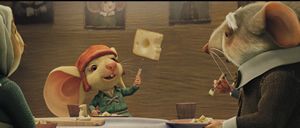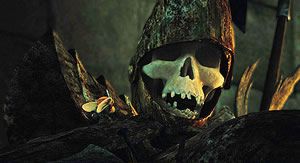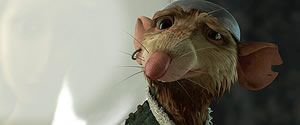
Despereaux is a big cheese when it comes to bravery All picutres © 2008 Universal Studios. ALL RIGHTS RESERVED.
Considering that Universal Pictures have a history stretching back more than 60 years, it seems incredible to think that The Tale Of Despereaux – about a little mouse with a big heart (among many other things) marks their first venture into animation. Adapted from Kate DiCamillo’s children’s book, the story, involving would-be knights, would-be princesses and spanning the worlds of mice, rats and men, has an epic sweep and a traditional fairy tale feel as each character goes on a journey of self-discovery. Co-director Sam Fell says: “We spent a lot of time with our animators trying to find an understated style of animation that allowed you to consider a bit more of what was going on inside each of these characters.” The end result – featuring the voice talents of Matthew Broderick (Despereaux) and Dustin Hoffman (Roscuro) - draws on influences as diverse as gentle and domestic work of Dutch master Vermeer and the nightmarish visions of Hieronymus Bosch. We caught up with modelling supervisor Ben Lambert, to talk about his role in bringing Despereaux to life.
AW: Could you tell us a little bit about your role as a modeller on the film and how your work fits with that of the other animators?
BL: On average, we had a team of around 10 very talented modellers throughout the production. They would be responsible for creating the thousands of 3D models and huge sets you see in the film, using the artwork as reference.
As a modelling supervisor, you are responsible for making sure all the models are created to the best standard possible in the given time, and steering the artists towards their goals. I was also fortunate to be able to do a lot of modelling myself on the show, making Despereaux and Roscuro.
One challenge of character modelling is to make sure the characters we provided rigging and animation for would be able to articulate and talk convincingly. They needed to act through a wide range of emotions, whilst keeping their design true. This is always more challenging when every character has their own personality and style.
AW: You've previously worked on live action films including Harry Potter And The Goblet Of Fire and Alien Vs Predator, can you tell us about how working on a fully animated feature differed - did you face new challenges?
 |
AW: How much does the choice of voice actor influence the way in which the animation is developed?
I believe we were well into the model making on Despereaux and Pea when we heard that Emma [Watson] and Matthew had been cast, so we (in modelling) didn't consciously change the models to suit the voice actors. Once in animation and rigging though, a lot more focus can be placed on expressions and, of course the dialogue, and this is where the personality and traits of the voice actors come through.
AW: There are a lot of different 'camera angles' used in the scenes in the film, so that we are frequently thrust into the centre of the action with sweeping shots that bring us very 'close' to the characters, this makes this film feel very different in terms of animation than those produced by other studios, can you tell us how this idea was developed.
 |
AW: Finally, can you tell us a little about your future projects?
BL: I can't discuss anything right now, sorry. I am involved again in VFX for film but would also love to work again on another CG feature in future.





















